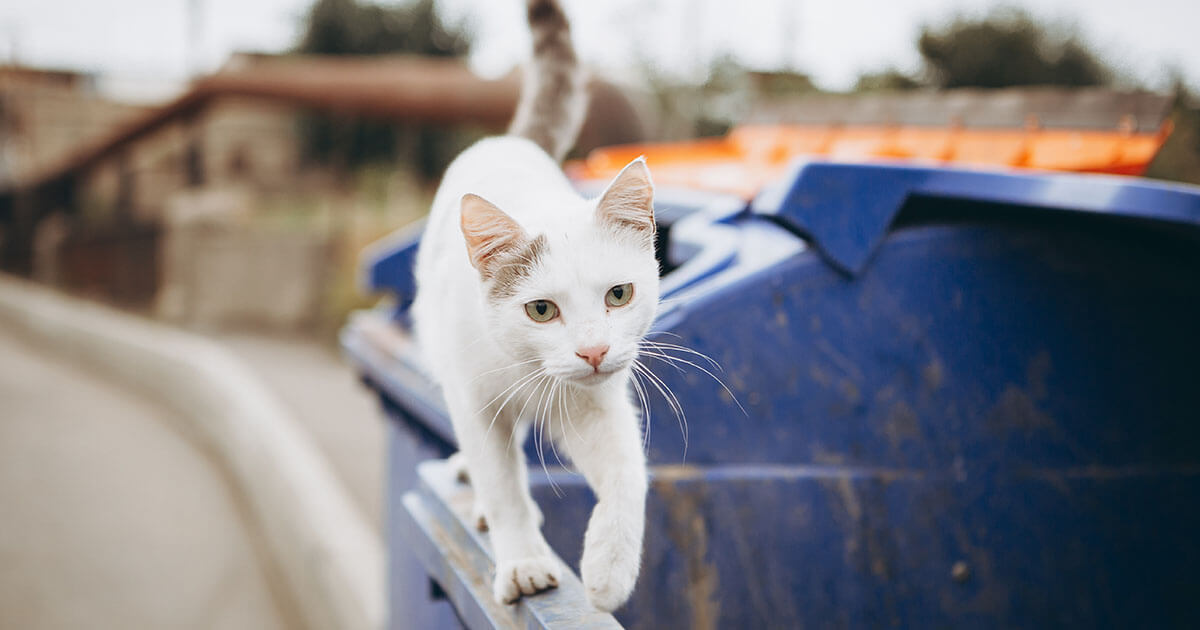A stray cat that won’t stop meowing may be hungry, stressed, or seeking attention. Ensure the cat is safe and consider taking it to a vet.
Dealing with a vocal stray cat can be both concerning and puzzling. Constant meowing is a cat’s method of communication and it often indicates a variety of needs or issues. As a responsible person encountering a persistently meowing stray, your first step should be to assess the situation for any immediate dangers to the cat’s health or wellbeing.
Satisfying basic needs such as hunger or thirst might provide a quick solution. Yet, there are times when meowing indicates more complex issues like stress, illness, or the desire for companionship. Observing the cat’s behavior, offering food and water, and creating a safe space can help in identifying the reason behind its persistent vocalizations. In cases where the cat’s needs exceed your ability to help, contacting local animal services or a veterinarian is the best course of action to ensure the animal’s health and safety.

Credit: www.newyorker.com
The Mystery Of The Meowing Stray
Imagine a cat weaving through the streets, its meows echoing in the silence of night. Your heart reaches out to this furry mystery, wanting to decode its persistent calls. Stray cats often vocalize for many reasons, but a stray that won’t stop meowing ignites intrigue and concern. Let’s explore the secrets hidden in those meows and understand why this stray just can’t stay silent.
Decoding Cat Vocalizations
Cats communicate in varied, subtle ways. Meowing is one form of their language. Each meow from a cat is a unique message intended to express a need or desire. Encounters with a persistent meower demand our attention and curiosity about what they try to say.
| Meow Type | Possible Meaning |
|---|---|
| Short meow | Greeting or hello |
| Mid-pitch meow | Plea for something, like food or attention |
| Long, drawn-out meow | Demands or complains about something |
| Low-pitched meow | Indication of pain or annoyance |
Familiarizing oneself with these vocal cues can unlock the mystery behind a stray’s relentless meowing.
Reasons Behind Excessive Meowing
- Hunger: Strays often lack regular meals, so they meow to express their need for food.
- Attention: Some crave human interaction and will meow for affection.
- Health Issues: Persistent meowing may signal pain or discomfort needing a vet’s attention.
- Mating Calls: If not neutered, their meows might be a call for mates.
- Stress: Changes in the environment can lead to anxious meowing.
Observing the stray’s behavior, along with the pitch and frequency of meows, may reveal the cause of their vocal persistence.
Encountering a meowing stray cat stirs our innate desire to understand and assist these independent yet vulnerable creatures. By decoding their vocalizations and reflecting on the possible reasons behind their meows, we grasp a deeper understanding of their world. The next time you hear a meowing stray, consider it a gentle reminder of the complex and fascinating language of cats.

Credit: www.amazon.com
Common Misconceptions About Stray Cats
Stray cats often spark discussions filled with myths. They roam our neighborhoods, and their meows tug at our heartstrings. Many believe these creatures understand human kindness naturally. Yet, misconceptions skew our views. Let’s debunk these and embrace the reality of stray cat behavior.
Myth Vs. Reality Of Stray Behavior
The sounds of a stray cat meowing can lead to false impressions. People sometimes think these cats are always in distress or they are aggressive. Truth paints a different picture.
| Myth | Reality |
|---|---|
| Strays are always hungry. | They may have found food sources we’re unaware of. |
| They are unfriendly. | Given time, strays often warm up to compassionate humans. |
| All meows signal danger or need. | Meowing can be a form of communication or an attempt at interaction. |
Understanding these cats helps us respond better to their meows. Fear often stems from false beliefs. Knowledge changes our interactions with these feline neighbors.
Understanding Feline Independence
Stray cats showcase a level of independence not always seen in domestic ones. This trait is sometimes mistaken for rejection or malice. Cats are survivors, adapting to their surroundings on their own terms. This independence doesn’t mean they won’t appreciate a helping hand. It highlights their ability to cope in various situations.
- Self-sufficient even in harsh conditions.
- May seek human interaction on their own terms.
- Capable of forming bonds if shown consistent kindness.
A better grasp of their independence can guide our actions. A stray cat won’t stop meowing? It’s not just a call for food. It might be in search of a connection or signaling a range of needs.
The Silent Treatment: Strategies To Calm A Vocal Stray
You’ve found a stray cat, and it’s been meowing nonstop. This can be a sign of many things – hunger, stress, or the need for attention. But don’t worry, there are strategies to help calm your new feline friend. Let’s explore how you can give the ‘silent treatment’ and create peace for both you and the cat.
Creating A Safe Environment
Comfort is king for a vocal stray cat. Your first task is to craft a place where the cat feels secure and protected.
- Start by setting up a warm, cozy bed in a quiet corner.
- Ensure that there are hiding places like boxes or open cabinets.
- Keep the space free from loud noises and sudden movements that could startle the cat.
A familiar spot with consistent surroundings can reduce anxiety and excessive meowing.
Routine And Feeding: Keys To Tranquility
Cats thrive on predictability. Establishing a routine helps minimize stress and excessive vocalization.
| Activity | Time |
|---|---|
| Regular Feeding Times | Same time each day |
| Play Sessions | At least twice daily |
| Quiet Time | After meals and play |
Consistency with these activities fosters a calming environment, reducing the urge to meow for attention.
Health Check: When Meows Signal More
Stray cats often meow to demand attention or food.
Sometimes, meowing can point to health issues.
Identifying Signs Of Illness Or Injury
Not all meows are created equal.
Delay in seeking help can be dangerous for a stray cat.
- Excessive meowing might mean pain or discomfort.
- Look for changes in behavior or appetite.
- Check for wounds, limping, or signs of infection.
- Notice respiratory issues or uncontrolled movements.
When To Seek Veterinary Help
Contact a vet if you spot concerning signs.
| Symptom | Action |
|---|---|
| Wounds or swelling | Immediate vet visit |
| Continuous meowing | Consult a vet soon |
| Eating less or not at all | Observe, then vet if persists |
Early detection and action can save lives.
Bonding With A Feral Feline
Scared eyes peek from behind a dumpster. Whiskers twitch with wariness, and a low meow breaks the silence. You’ve noticed a stray cat that seems to demand attention with constant meowing. Does this sound familiar? Bonding with a feral cat can be a rewarding challenge, transforming a cautious creature into a trusting feline friend.
From Stranger To Familiar: Trust-building Techniques
Gaining a stray cat’s trust can take time, patience, and understanding. Start slowly, offering food to create a positive association with your presence. Regular feeding times not only form a routine but also show you’re dependable. Below are some steps to build trust:
- Be patient and let the cat approach you
- Speak softly to convey a sense of safety
- Avoid direct eye contact initially; it can be threatening
- Use treats to coax the cat closer
- Extend a hand and allow the cat to smell you
Consistent, gentle interactions pave the way for a lasting bond.
The Role Of Play In Reducing Meows
Playtime isn’t just fun—it’s vital in creating a bond and reducing meows. Interactive toys like feathers on a string mimic hunting behaviors. This engages the cat’s mind and body, often decreasing the need to meow for attention. Introducing play can be easy:
- Choose a quiet time when the cat seems relaxed
- Introduce toys slowly and observe the cat’s reaction
- Encourage play but don’t force it; let the cat lead
- Set aside regular times to play to establish a routine
Engagement through play fosters trust, providing mental stimulation and an outlet for energy, leading to a calmer, less vocal cat.
Fostering Community Understanding
The incessant meowing of a stray cat can capture the attention of an entire neighborhood. Fostering Community Understanding offers a compassionate approach to address the challenges and needs of these feline wanderers. Embracing education and community-driven solutions fosters a harmonious coexistence between stray cats and residents.
Educating Neighbors About Stray Cats
Stray cats often meow due to hunger, stress, or the need for a safe shelter. Informing neighbors about the reasons behind this behavior can inspire kindness and patience. Consider the following steps:
- Share Flyers: Distribute informative flyers that explain why stray cats meow and how to help.
- Organize Meetings: Host community gatherings to discuss stray cat welfare and responsible feeding.
- Start a Social Media Group: Create an online platform to share tips and coordinate care for stray cats.
Community Solutions For Stray Cat Management
Implementing community-wide strategies ensures the well-being of stray cats and minimizes unwelcome meowing. Here are some practical solutions:
- Trap-Neuter-Return (TNR): Encourage participation in TNR programs to control the stray population.
- Build Shelters: Collaborate to create safe outdoor shelters for strays to protect them from the elements.
- Feeding Schedule: Coordinate feeding times to prevent overpopulation and reduce noise.
A united community approach to stray cat management can lead to peaceful coexistence. It starts with understanding and ends with collaborative action.

Credit: www.newyorker.com
Frequently Asked Questions For Stray Cat Won’t Stop Meowing
What To Do When A Stray Cat Won’t Stop Meowing?
Check if the stray cat needs food, water, or medical attention. Offering a safe space can calm it down. If incessant meowing persists, consult a vet or local animal rescue for advice.
Why Does A Stray Cat Keep Yowling?
A stray cat may yowl due to hunger, seeking attention, mating calls, territorial presence, or discomfort from illness. Ensure content provides value and is unique.
Why Does A Stray Cat Keep Meowing At My Front Door?
A stray cat may meow at your front door seeking food, shelter, attention, or to signal distress. Establishing a routine interaction could also encourage this behavior.
Why Is There A Cat Meowing Outside My House?
A cat meowing outside your house could be hungry, seeking attention, or in heat. It may also be lost or signaling territory. Consider checking for a collar or tags to ensure it’s not a missing pet.
Conclusion
Understanding the reasons behind a stray cat’s constant meowing can bring peace to both the animal and your neighborhood. Providing care, while also respecting their independence, is key. Remember, patience and kindness go a long way in earning animal trust.
Tend to their needs and you may just make a new friend for life.

